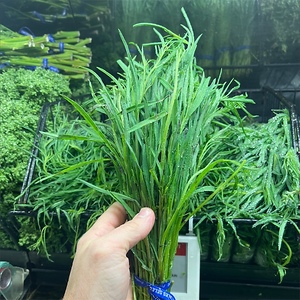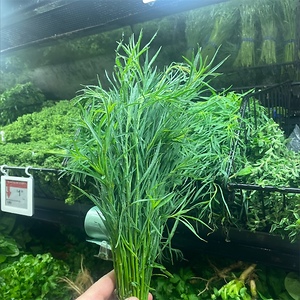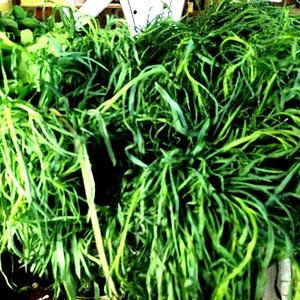


Pipicha
Estimated Inventory, bunch : 0
Description/Taste
Pipicha is a grass-like herb that has tall and slender, pale green stems with elongated and narrow, aromatic green leaves. The dark green, oval leaves are pliable, thin, and smooth, and purple-blue flowers also form at the top of the mature stems. Each flower encases seeds, causing the stems to sometimes bend under the weight of the top-heavy bloom. Pipicha has an aromatic scent reminiscent of mint and pine and contains a distinct, robust flavor with grassy, herbaceous, citrusy, and anise-like nuances. The herb is often compared to cilantro but has a more robust, green, and peppery taste.
Seasons/Availability
Pipicha is available fresh in the late spring. When dried, the herb is available year-round
Current Facts
Pipicha, botanically classified as Porophyllum tagetoides, is an ancient Mexican herb belonging to the Asteraceae family. The slender leaves grow in upright, wispy groupings that can reach up to one meter in height and are said to have a flavor profile similar to cilantro with a more pungent taste. Pipicha is also known as Pepicha, Chepiche, Cola de Coyote, and Tepicha and is often confused with another Mexican herb, pápalo, which has broader-shaped leaves and a different flavor profile. The herbaceous greens have been utilized as a culinary ingredient and medicinal aid among indigenous peoples throughout southern Mexico, sold through local markets, and harvested from wild plants. Pipicha is also grown in home gardens, favored as an ornamental and edible landscaping variety.
Nutritional Value
Pipicha is a source of vitamin C to strengthen the immune system and vitamin B to improve energy levels and metabolism. The herb also contains calcium to protect bones and teeth and iron to build the protein hemoglobin for oxygen transport through the bloodstream. In Mexico, Pipicha was historically used as a palate cleanser after meals and was incorporated into natural medicines to help prevent bacterial infections.
Applications
Pipicha has a robust, citrusy, and herbaceous flavor best suited as a fresh garnish or finishing flavor on a wide array of savory dishes. A little of the herb goes a long way, and the leaves can be roughly chopped and added to salads, salsas, sauces, and devilled eggs, or they can be mixed into grain-based or potato side dishes. Pipicha is also utilized as a topping over tacos, enchiladas, and tamales, layered into sandwiches, stirred into soups and stews, or incorporated into bean and vegetable dishes. The zingy, grassy flavor of Pipicha complements many different meats, including poultry, chorizo, and beef, and the herb can also be sprinkled over white fish for added flavor. Pipicha pairs well with tomatillos, tomatoes, corn, squash, black beans, mushrooms, poblano peppers, cotija cheese, and watercress. The herb has a delicate nature and will only keep for 1 to 3 days when stored in a plastic bag in the refrigerator.
Ethnic/Cultural Info
Pipicha is a staple springtime herb utilized in Oaxacan cuisine. Oaxaca is a state in southwestern Mexico known for its biodiversity, leading to a wide range of hyperlocal cuisine that has gained international recognition. Traditional Oaxacan meals consist primarily of vegetables, chiles, and herbs, and Pipicha is a favored green utilized as a fresh, bright flavoring. Pipicha is most famously used in sopa de guias, a soup comprised of herbs, squash flowers, squash, and squash vines. Sopa de guias was originally a field soup, which is an everyday meal where miscellaneous vegetables and herbs were gathered by farmers and combined into a light, cleansing dish. The soup may also contain other ingredients, including corn and chochoyotes, small corn dumplings. In Oaxaca, Pipicha is often sold prepackaged with ingredients needed to make sopa de guias in fresh markets. The herb is also sold by itself in bunches, used as a finishing flavoring on tlayudas, also known as Oaxacan pizzas, mixed into arroz blanco as a side dish, or stuffed into garnachas de calabacitas, fried masa patties filled with quinoa, squash, tomato, and corn.
Geography/History
Pipicha is native to the states of Puebla and Oaxaca in southern Mexico and has been growing wild since ancient times. The herb has been cultivated by indigenous populations and is traditionally utilized as a culinary and medicinal ingredient. Outside of southern Mexico, Pipicha is challenging to find and is grown on a small scale in Central America and the American Southwest, including California. Pipicha thrives in warm climates and is seasonally found fresh in local markets in the spring. Dried Pipicha can be found year-round through select online retailers, specialty distributors, and Mexican markets.
Recipe Ideas
Recipes that include Pipicha. One
| The Wanderlust Kitchen |
|
Poblano Chicken Tacos with Pipicha |
| Sunset Park CSA |
|
Salsa verde with pipicha |











